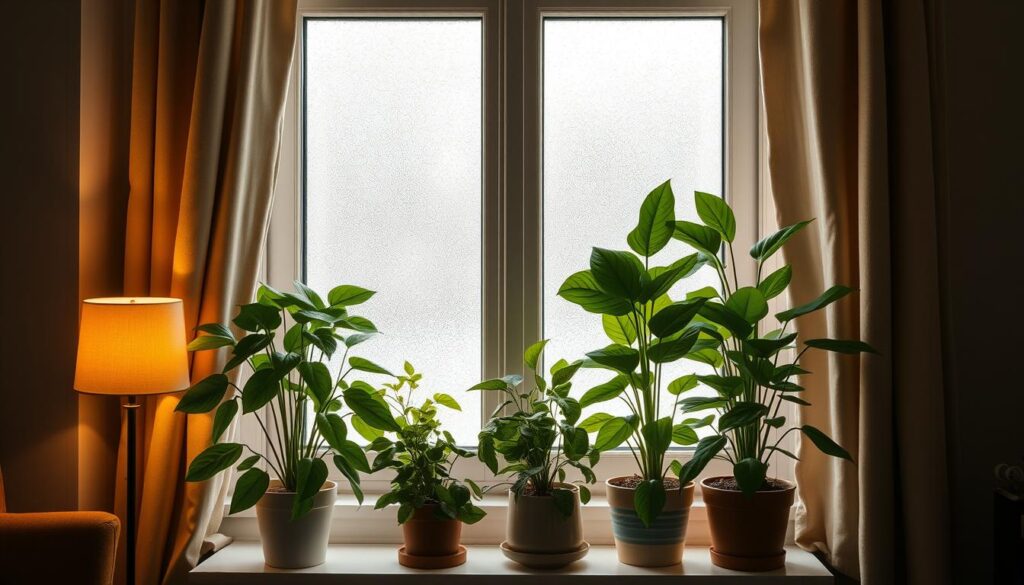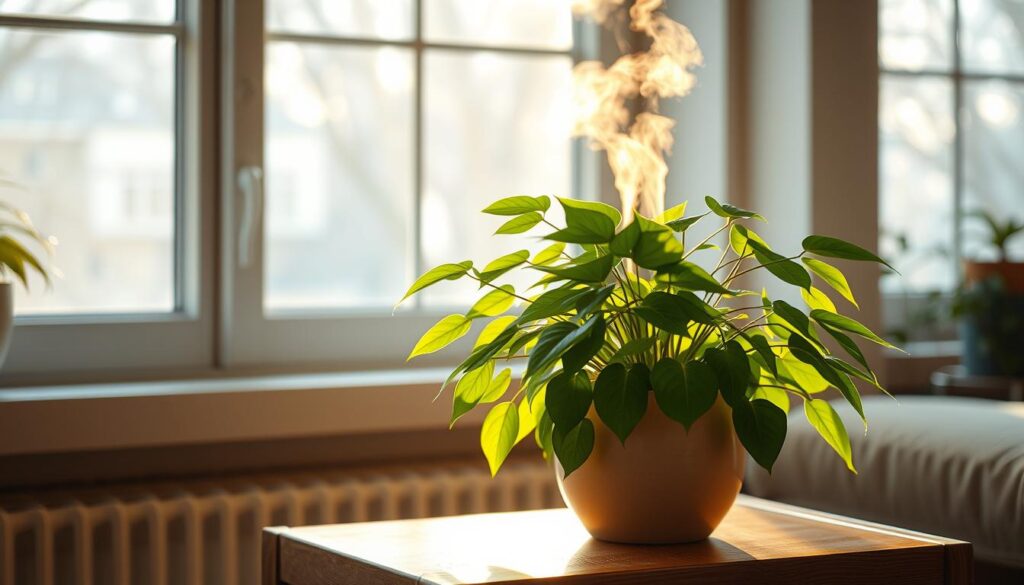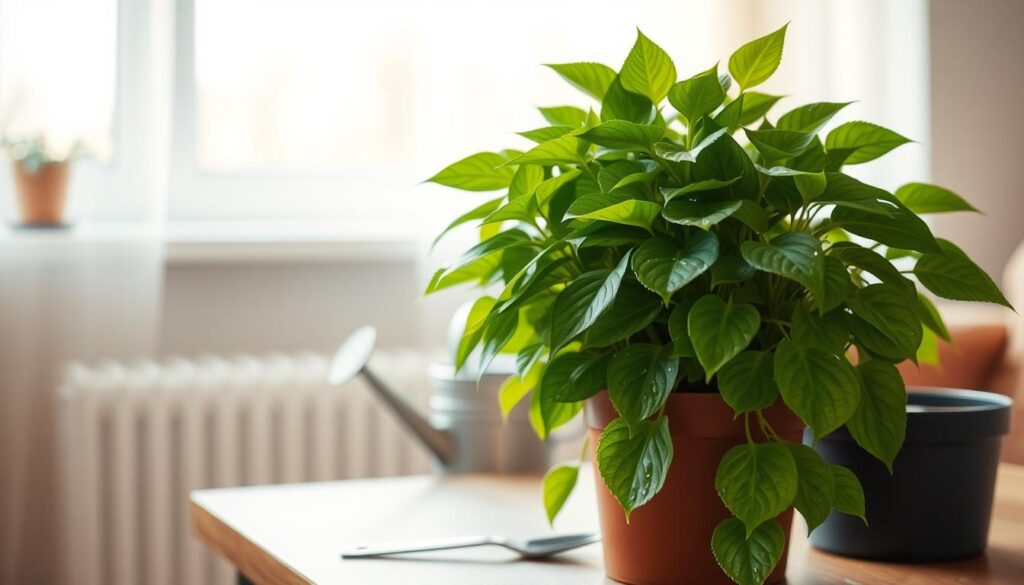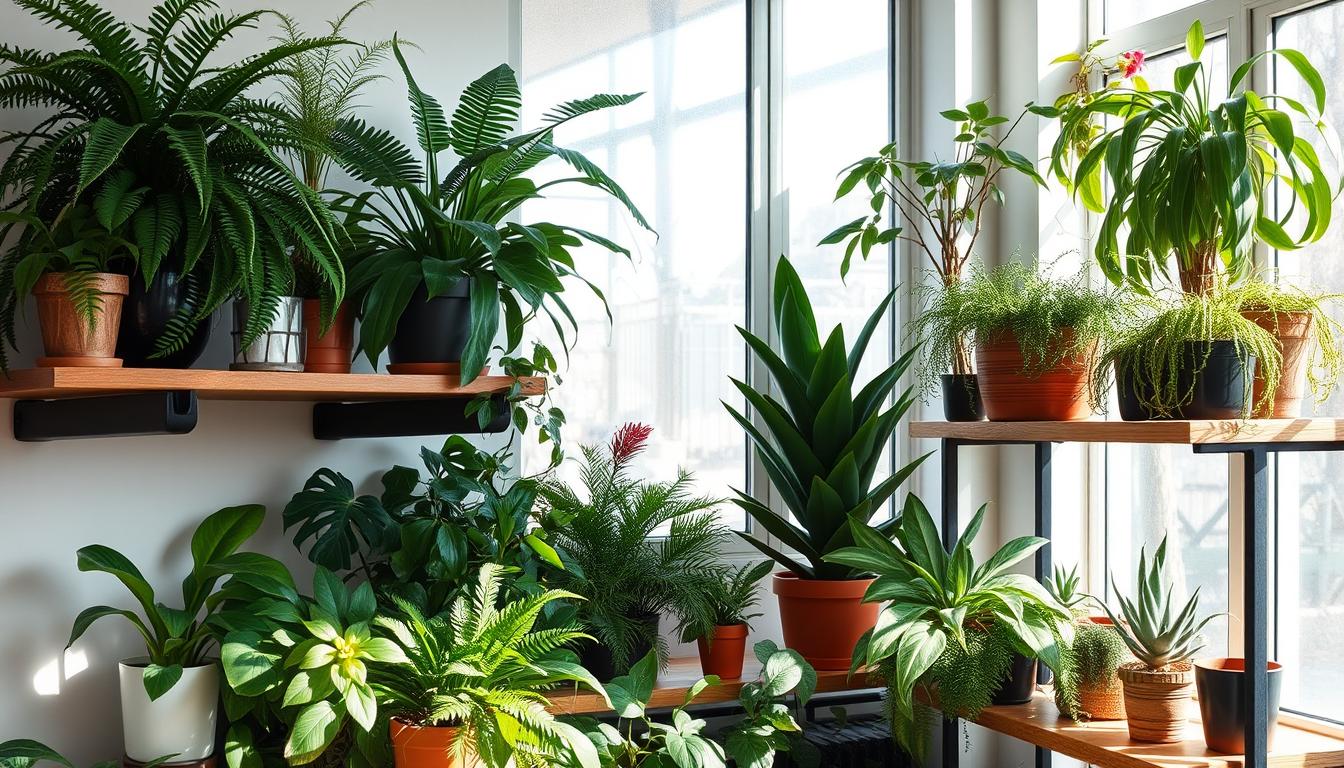When the winter chill sets in, your beloved plants need extra care. The air is dry, sunlight is less, and it’s colder. These changes can be tough for plants.
To help your plants stay healthy until spring, you need to change how you care for them. Make sure the air is not too dry. Give them the right amount of light. And keep them safe from very cold or hot temperatures.
Key Takeaways
- Adjust your watering schedule according to the humidity levels.
- Provide the right amount of light for your plants.
- Protect your plants from extreme temperatures.
- Maintain a humid environment to combat dry air.
- Monitor your plants’ health and adjust your care routine according to.
Why Winter Presents Unique Challenges for Houseplants
Winter is tough for houseplants. Days are shorter and it’s colder. They need special care to stay healthy.
The Science Behind Winter Plant Dormancy
Many plants slow down in winter. They grow less and need less water. This helps them save energy.
How Indoor Heating Systems Affect Plant Health
Heaters dry out the air. This stresses plants. It can cause leaves to fall off and attract pests. To fix this, add moisture around your plants.
Recognizing Winter Stress Signals in Your Plants
Stressed plants show signs. Look for yellow leaves, slow growth, or droopy stems. Changing how you care for them can help them make it through winter.
| Common Winter Stress Signals | Possible Causes | Action to Take |
|---|---|---|
| Yellowing Leaves | Overwatering, dry air | Adjust watering schedule, increase humidity |
| Slow Growth | Reduced light, cooler temperatures | Provide supplemental lighting, maintain warmer temperatures |
| Droopy Stems | Underwatering, root damage | Check soil moisture, inspect roots for damage |
Knowing these challenges helps you care for your plants better. For more winter plant care tips, look into caring for indoor plants in cold weather.
Essential Indoor Plant Care During Winter: The Basics
Caring for indoor plants in winter needs careful attention. The days are 6 and colder. Your plants have different needs now.
“The key to keeping your plants healthy is understanding their needs during the winter months,” says a renowned horticulturist.
Adjusting Your Care Routine for Winter Conditions
In winter, most houseplants need less water and food. Water them less, letting the soil dry a bit. Don’t fertilize as much, as they don’t need as many nutrients.
Creating a Winter Plant Care Calendar
Use a calendar to keep track of your plant care. Note when you watered, fertilized, or pruned. This helps you remember to care for your plants. Consistency is key to keeping them healthy.

Tools and Supplies for Winter Plant Maintenance
Having the right tools is important for winter plant care. Get a humidifier to fight dry air. Grow lights help when there’s not enough natural light. A moisture meter helps know when to water.
By making these simple changes and staying organized, your indoor plants will do well in winter. The goal is to give them the best conditions until spring.
Mastering Light Requirements in Low-Light Months
Winter brings less daylight, affecting your indoor plants. It’s key to meet their light needs to keep them healthy.
Maximizing Natural Light Exposure
Put your plants near windows for direct sunlight. South-facing windows get the most sun. Mirrors can also reflect light, helping your plants get more.
Choosing the Right Grow Lights for Different Plant Types
Grow lights help when natural light is not enough. Different plants need different lights. LED grow lights are good for many plants because they’re energy-saving and versatile.
Creating a Rotation Schedule for Even Light Distribution
Rotate your plants to get even light. Move them every few days. This stops uneven growth and keeps plants healthy.
Best Window Placements for Winter Plant Health
Where you put your plants matters in winter. East- and west-facing windows are good for plants that like partial shade. Stay away from drafty or cold windows to avoid plant stress.
With these tips, you can keep your indoor plants healthy and bright all winter.
Temperature Management to Prevent Cold Damage
Winter is here, and keeping your indoor plants warm is key. Cold temperatures can harm your plants. They might get sick or attract pests. It’s important to keep the temperature right for your plants to stay healthy.
Ideal Temperature Ranges for Common Houseplants
Most houseplants like it between 65-75°F (18-24°C) during the day. At night, they prefer it to be around 55-65°F (13-18°C). But, some plants need warmer or cooler homes.
- Tropical Plants: Above 60°F (15°C)
- Temperate Plants: 65-75°F (18-24°C) during the day, 55-65°F (13-18°C) at night
- Cacti and Succulents: Can tolerate cooler temperatures but generally prefer above 50°F (10°C)
Protecting Plants from Drafts and Cold Windows
Cold drafts and windows can harm your plants. Keep them away from cold spots. Use draft stoppers or thick curtains to keep the area warm.

Safe Distances from Heating Vents and Radiators
Keep plants away from heating vents and radiators too. The hot air can dry out the soil and hurt the plant. Make sure they’re far enough away to stay safe.
Using Temperature Zones in Your Home
Every part of your home has its own temperature. Rooms with south-facing windows are warmer. North-facing rooms are cooler. Place your plants where they’ll be most comfortable.
By controlling the temperature, you can keep your plants safe from cold damage. Know what your plants need and adjust their home as needed.
Humidity Boosting Techniques for Dry Winter Air
Winter brings dry air that’s hard on indoor plants. This dry air can stress them out, causing leaves to drop and growth to slow. Keeping humidity levels right is key to keeping your plants healthy.
Measuring and Monitoring Indoor Humidity Levels
To manage humidity, you first need to measure it. A hygrometer is the easiest way to check indoor humidity. You want humidity between 40% to 60% for most plants. If it’s too low, you’ll need to find ways to make it higher.
Effective Humidifier Options and Placement
Humidifiers can directly increase humidity. There are cool mist, warm mist, and ultrasonic humidifiers. Cool mist humidifiers are best for plants because they don’t heat up the room. Place the humidifier near your plants but not too close to avoid waterlogged soil or fungal growth.

DIY Humidity Trays and Pebble Basins
Using DIY humidity trays or pebble basins is a simple and cheap way to boost humidity. Fill a tray with water and add pebbles. Then, put your plant pot on top. As the water evaporates, it makes the air around your plant more humid. Make sure the pot isn’t in water to prevent root rot.
Misting: Which Plants Benefit and Which Don’t
Misting can help increase humidity for plants like ferns and orchids. But, not all plants like misting. Succulents and cacti prefer drier air. Use a spray bottle to mist, but don’t overdo it to avoid fungal diseases.
Creating Microclimate Zones for Humidity-Loving Plants
For plants that need more humidity, create microclimate zones. Grouping plants together helps keep the air humid around them. You can also use a cloche or terrarium to make a humid spot for sensitive plants.
Winter Watering: Avoiding the Most Common Mistakes
Winter brings dry air and cold. Your houseplants need less water. But, many people still water too much. It’s important to know how to water them right.
Developing a Winter-Specific Watering Schedule
Make a watering plan for winter. Check the soil moisture often. Adjust how often you water based on your plants’ needs and the weather.
Most houseplants drink less water in winter. This is because the air is dry and it’s colder.
Testing Soil Moisture Before Watering
Check the soil moisture before you water. Stick your finger into the soil up to the first knuckle. If it’s dry, it’s time to water.
If the soil is already moist, wait a bit longer. This trick helps avoid too much water and root rot.

Water Temperature and Quality Considerations
Water should be at room temperature. Cold water can hurt the roots. Hot water can also damage them.
Use filtered or distilled water. Tap water has minerals and chemicals that can harm plants over time.
Drainage Solutions for Winter Months
Make sure your pots have holes for water to drain. You can also add small rocks or broken pottery at the bottom. This helps prevent waterlogged soil and keeps your plants healthy.
Adjusting your watering and ensuring good drainage helps your plants survive winter. Be aware of the changes and adapt your care routine.
Fertilizing Strategies During Plant Dormancy
Winter is a time to change how we feed our indoor plants. They grow slower and need less food.
When to Reduce or Pause Fertilization
Many houseplants sleep during winter. They need less food. Knowing your plants’ needs is key.
- Succulents and cacti don’t need much food in winter.
- Tropical plants still need some food, but less than usual.
Low-Dose Winter Fertilizers Explained
Low-dose winter fertilizers are good for your plants. They give the right amount of nutrients without harming them.
Low-dose winter fertilizers have:
| Characteristic | Description | Benefit |
|---|---|---|
| Lower NPK Ratio | Less nitrogen, phosphorus, and potassium | Prevents too much food |
| Balanced Formula | Equal amounts of NPK | Keeps plants healthy |
| Micronutrients | Includes important nutrients like iron and zinc | Makes plants stronger |
Plants That Benefit from Winter Feeding
Some plants grow a bit in winter. They need a little food.
- Orchids and some plants that bloom need food.
- Plants in sunny, warm spots need more food than others.
Signs of Fertilizer Burn and How to Prevent It
Fertilizer burn is bad for plants. Spotting it early helps fix it.
Look out for:
- Yellow or brown leaf tips
- Leaves that droop or wilt
- Slow or no growth
To avoid fertilizer burn, follow the package’s advice. You might also want to make the fertilizer weaker.
Preventing and Treating Winter Pest Infestations
Winter makes indoor plants more likely to get pests. The dry air and warm air from heaters are perfect for pests. It’s important to act fast to keep your plants safe.
Spider Mites, Mealybugs, and Scale: Winter’s Most Common Pests
Spider mites, mealybugs, and scale are common pests in winter. Spider mites turn leaves yellow or bronze. Mealybugs leave a sticky mess that attracts more pests. Scale sucks sap, making plants weak.
Weekly Inspection Routines to Catch Problems Early
Checking your plants weekly is key. Look for eggs, white stuff, or bugs on leaves or stems. Finding pests early helps treat them better.
Natural and Chemical Treatment Options
For small problems, try neem oil or insecticidal soap. For big issues, you might need chemical pesticides. Always read the label and be careful.
Quarantine Procedures for New or Affected Plants
Isolate new plants or ones with pests right away. Keep them separate until the problem is gone. This stops pests from spreading.
Stay alert and act quickly to keep your plants safe from pests. This way, they’ll stay healthy until spring.
Conclusion: Setting Your Plants Up for Spring Success
Winter is ending, and it’s time to get your plants ready for spring. You’ve made sure they did well during the cold months. You’ve learned how to manage light, temperature, and humidity for them.
Now, check your plants for any winter damage. Cut off dead or damaged leaves. Also, repot plants that have grown too big for their homes.
Start watering and fertilizing more as it gets warmer. Think about moving plants outside for more light and air. This will help them grow strong in the spring.
By following these steps, you’ll help your plants thrive in the spring. Keep watching over them as the seasons change. Enjoy the beauty and freshness they add to your home.
